This review page is supported in part by the sponsors whose ad banners are displayed below |
 |
More favorite rooms: Octave from Germany is a well-established valve electronics house. They shun triodes and single-ended circuits in favor of the three peas of push, pull and pentode. Designer/owner Andreas Hoffmann had set up his top Jubilee 8x6550 monos (250 watts into 4Ω) to drive very big Dynaudio speakers in a deep room and demonstrate that low-impedance bearish loads and tubes can get along just fine.
|
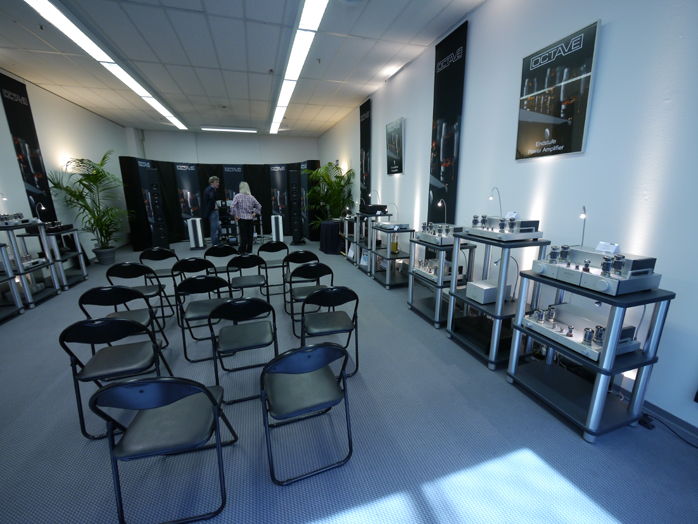 |
Having reviewed a number of his models and owned his big MRE-130 monos for a few years, this wasn't news as far as I was concerned. But it did make me wonder. Why did most of my favorite show rooms run on tubes whilst at home I favor transistor amps like the FirstWatt SIT1, SIT2 or Bakoon AMP11-R? I think the answer is real estate. The event's large spaces and concomitant room-filling energy required to play them convincingly favored valves. The much lower volumes I listen to in my smaller room necessitate ultimate resolution and separation. That favors very special transistor amps. Perhaps. It's just a theory. But it's why I sold off my Octave monos earlier this year. With the easy-drive speakers I own and favor, they never got out of first gear. They were redundantly powerful. I'd bought way more than I needed. Sounds familiar?
|
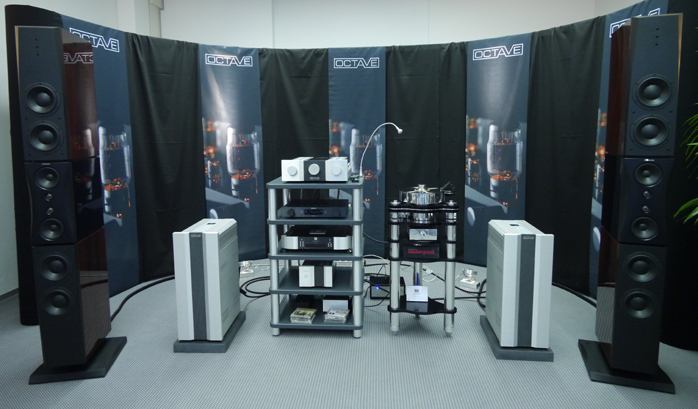 |
When Andreas asked me what I wanted to hear, I told him to surprise me. His clearly top-notch DJ asked whether some Bavarian music would suit. If it didn't yodel, why not was my reply. His choice of limited edition Übersee album from the LaBrassBanda turned out to be one ultra-hip hybrid of Rap, Funk and inexplicables which promptly cleansed my ears from the audiophile pablum encountered elsewhere. I felt restored and ready to resume battle.
|
 |
In parting I grabbed this skirt-up shot of the Octave phono module even though I'm homo digitalus born without that special vinyl gene. But not all of us are. Vinyl remains alive and well despite predictions to the contrary.
|
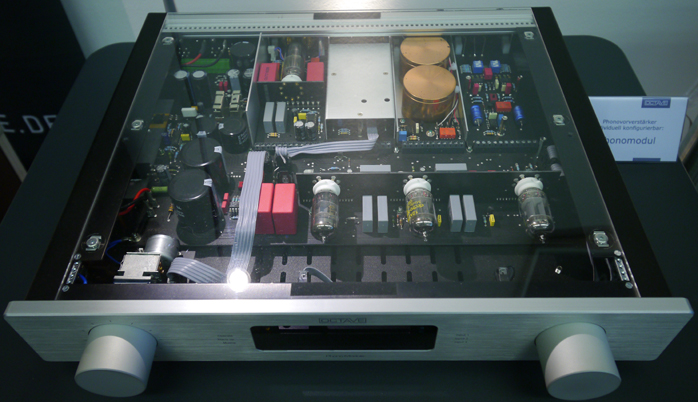 |
And whilst we're on the never say never topic, the Japanese have petitioned Andreas Hoffmann to come out with a triode amp. Since his lineup is complete and freshly updated, he might just consider it. But high-power triodes with 1000 volts on the rails won't be on the menu. For high power his standard push/pull pentode amps are ideal. He'd probably pursue a 300B amp just because. "It could be fun" he chuckled, no commitments implied.
|
|
|
TuneAudio from Greece had two rooms this year, one in the standard downstairs cubicle (windowless), one airy one upstairs. Two years ago their big room with Aries Cerat valve gear from Cyprus and their own big Anima horn with Pulse horn subwoofer had factored amongst my favorites. This year the same speakers driven from a combination of TotalDAC with digital volume control and Engstrom&Engstrom The Lars 300B monos didn't come close. Now it were the small rear-hornloaded 93dB Prime with Fostex 6.5" widebander and matching hornloaded tweeter and 1st-order filters at 6.3kHz on either driver that had my attention to sign up for a review.
|
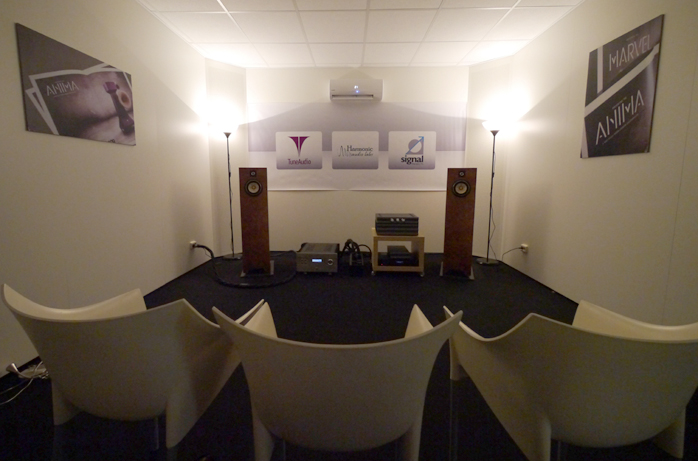 |
Their veneered Baltic Birch Ply cabs were set up with the big class A SE-100 integrated from Greece's Harmonic Audio Labs and fronted by a very modest CD player of Marantz/Arcam pedigree. In my review of Martin's soundkaos Wave 40 speaker I'd commented on his rare but successful choice of low-passing his widebander plus adding a Raal ribbon tweeter to augment the top. In widebander circles, crossovers are usually frowned upon as devil's spawn and thus avoided like the plague. As a result the range where widebanders always get nonlinear and ragged—between 3.000 and 8.000Hz contingent on driver size—is unceremoniously exposed to give the breed a bad rep. With the Prime designer Manolis Proestakis followed Martin Gateley's lead. The results really spoke for themselves. And like Crystal Cable's Gabi van der Kley, Manolis' wife Masa Josilo was a concert pianist who unlike Gabi remains an active piano teacher. Should one expect that a constant reminder about what a real instrument sounds like is of invaluable benefit to designers like Manolis? I'd say so.
|
 |
Here is the big TuneAudio system with Bibacord cabling. Apparently the Swedes didn't get their preamp finalized in time. Whether direct-driving their glass-ensconced 300B monos from the French DAC was the true cause of what compared to the prior showing felt somewhat listless and too laid back would be an academic speculation.
|
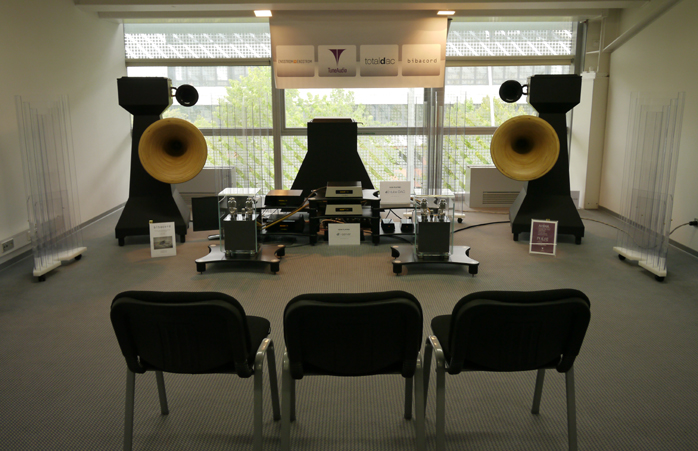 |
The sound simply didn't approach what it could have been. Such are the vagaries of joint exhibits.
|
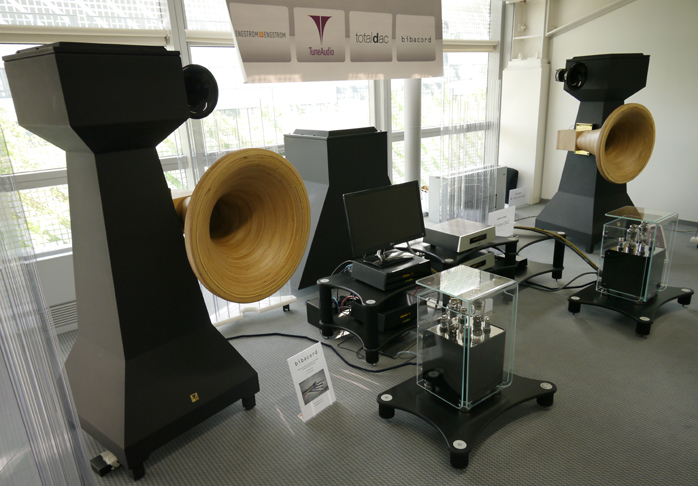 |
But if I had the requisite ground-floor space—my 2nd-floor room is accessed only via narrow flights of stairs with a tight bend to firmly eliminate speakers I can't carry—TuneAudio's Anima would be on the top of my list of hornspeakers to review. I still remember them that fondly from the 2011 show. The fact that their design remains unaltered suggests that on that count nothing has changed.
|
 |
|
|
|
Still from my camera's blue period,
Richard Vandersteen's Model 7 must be one of the most advanced yet still compact super speakers extant though it seems routinely overlooked for flashier though less sophisticated specimens. Where most competing flagships simply scale up their catalogue's middle models, Richard's add tuning smarts. First of course come custom drivers of which others have theirs. As an avid pilot well familiar with Balsa wood which is a staple of model airplanes, Richard spent years perfecting his own Balsa core drivers in the pursuit of optimal stiffness and low moving mass. Even his best home-rolled tweeter sports a waver-thin Balsa core with Carbon skins. His class A/B active bass sections rely on face-to-face curvilinear aluminum cones which are sandwiched together with an exotic honey-comb material. The cabinet sports Carbon-fiber cladding for additional sound deadening. Drivers are physically time-aligned and filter networks are exclusively minimum-phase 1st-order.
|
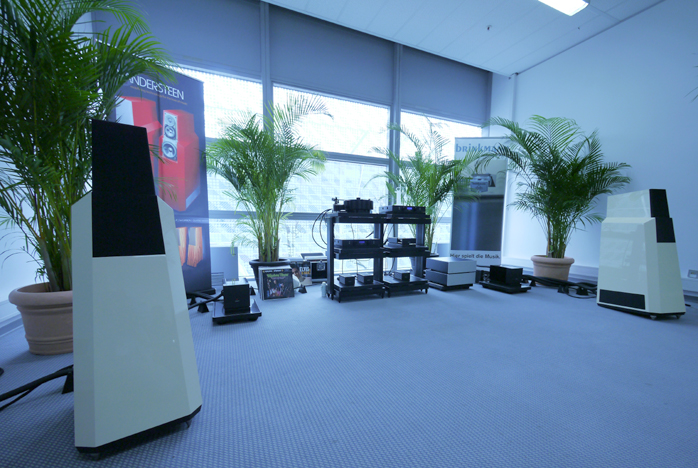 |
Then the real fun begins on the rear. Here 11 calibration points allow surgical bass EQ from 20-110Hz. This happens in the analog domain. Having tried automated DSP equivalents, Richard flatly stated that "without changing the microphone position, those never gave the same reading twice". Asked to sit in the chair from which he'd measured this room, I complimented him on being able to feel bass pulses through the soles of my shoes as mechanical energy migrating through the suspended floor whilst not hearing the same effects as acoustic resonances. "Some remains of course. When compensating for room nonlinearities—we had a massive peak at around 50Hz for example—I've learnt not to go after a perfectly flat response. Wherever there is a peak or dip, it's important to leave them. I correct for about 70%. If there's a 6dB peak, I'll leave it at 2dB. EQing for flat kills the sound. Minimizing room effects whilst leaving the room's fingerprint intact which the brain recognizes gives far better results." I certainly couldn't argue with the outcome.
|
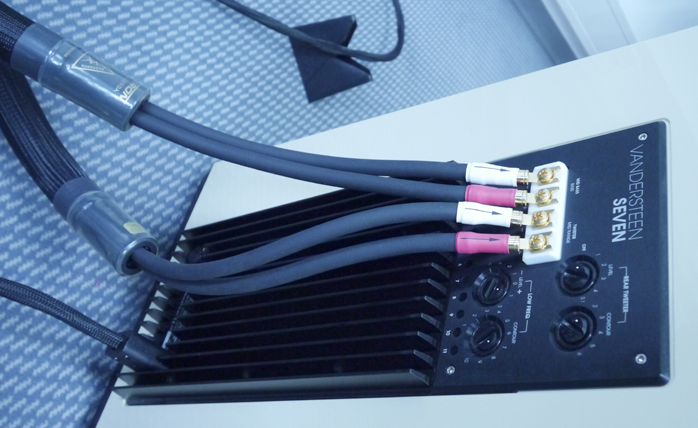 |
Where other flagship speakers played the boominator roulette and won—some big time so—the Model 7's superior brain power strategically bypassed that whole misery. This system fronted by analog and powered by solid-state German Brinkmann electronics was my final favorite getaway from the usual show conditions for which all of us in the know make well-informed excuses. Yet at the end of the day, that's all they are - sorry excuses. They tell the world at large (and newcomers to the hobby who attend a show expecting a Shangri-La of audio bliss) that we either don't know better; can't do better; don't give a shit; or consider this good enough. Bravo to those who refused to play roulette with our ears! |
  |
 |